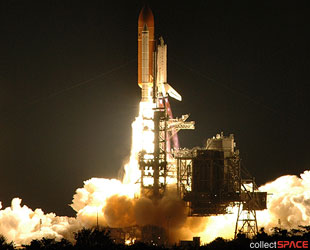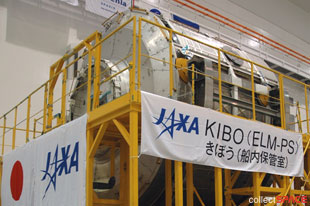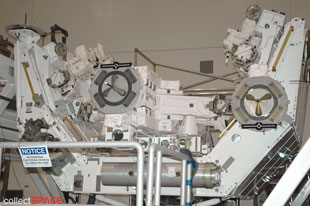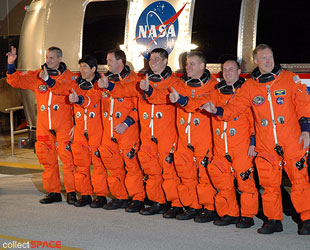|
|

|
Endeavour launches, carries 'Hope' and an extra pair of hands

| Endeavour launches from Pad 39A. Click to enlarge. |
March 11, 2008 — The International Space Station is a major step closer this morning to earning the "I" in its ISS acronym. For the first time since its assembly began in 1998, elements from each of the international partners are now in space.
Space shuttle Endeavour lit up the early morning horizon as it launched from Kennedy Space Center's Pad 39A at 2:28 a.m. EDT. Riding on the "rising sun" were the first of three sections that will comprise the Japanese laboratory Kibo, the Canadian two-armed robotic system Dextre and the seven-member crew of the STS-123 mission.
"We'd like to say konichiwa, domo arigato, and banzai!" radioed STS-123 commander Dominic Gorie just before Endeavour's engines ignited, setting the sky ablaze. "God has truly blessed us with a beautiful night to launch... so let's light 'em up and give 'em a show."
During Endeavour's ascent, the shuttle registered a pair of problems — a loss of telemetry data from two of its maneuvering thrusters and a forced switch to an alternate cooling system — but neither had an immediate effect on the Endeavour's climb into orbit.
| A "rising sun" lights the east. Click thumbnails to enlarge. |
Scheduled as a 16-day mission, the longest shuttle flight to the International Space Station to date, STS-123 will install the Japan Aerospace Exploration Agency's (JAXA) Experiment Logistics Module-Pressurized (ELM-PS) on the ISS, joining it with other modules built by the United States, Russia and the European Space Agency. Kibo's docking will be the first time that all 15 partner nations are represented by components of the ISS.
Two of the mission's five spacewalks (another record for space station flights) will be dedicated to assembling and deploying Dextre, which will complete the ISS's Mobile Servicing System. On another of the excursions, two of the astronauts will perform the final test for a shuttle tile repair techinque that was developed after the 2003 loss of Columbia. STS-123's final spacewalk will move a boom used to inspect the shuttle for damage from the orbiter to the station so as to allow room in the payload bay for the next and largest piece of Kibo.

| Kibo's ELM-PS as seen before its launch. Click to enlarge. |
Kibo, which means "hope", will increase the capability of the ISS to support a variety of research disciplines. The ELM-PS is the smaller of Kibo's two pressurized modules and will act as an "attic", sitting atop the larger laboratory and providing storage for experiments and supplies.
As Kibo's primary Pressurized Module will not launch until the next shuttle mission, STS-123 will temporarily berth the ELM-PS on the Italian-built, U.S. "Harmony" Node 2.
Kibo is Japan's first human-rated space facility and when completed will be the station's largest experiment module.
"With this flight, I believe we fully became a real partner in the International Space Station," said Keiji Tachikawa, president of JAXA.

| Dextre dissembled before flight. Click to enlarge. |
The two-armed Special Purpose Dexterous Manipulator, named Dextre by Canadian students, will be the largest robot ever deployed in space. Each of its 11-foot arms support a "hand" with built in socket wrench, camera and lights.
"Today we are marking another point in our space history," said Guy Bujold, director of the Canadian Space Agency.
Operated by astronauts inside the space station or flight controllers on the ground, Dextre is designed to increase crew safety by reducing the time astronauts must spend outside the station for routine maintenance.
A typical task Dextre might perform would be to replace a depleted battery and engage all of its connectors, which would involve bolting and unbolting, as well using Dextre's two millimeter positioning accuracy to install the new unit.
Dextre can either be attached to the end of Canadarm2, the station's robotic arm, or ride by itself on the Mobile Base System, a railcar that traverses the station's truss.

| The crew of STS-123 pauses before boarding the AstroVan and riding to launch pad 39A. Click to enlarge. |
Endeavour's crew is led by commander Dominic Gorie, a veteran of three earlier shuttle flights, and pilot Gregory H. "Box" Johnson. Robert Behnken, Mike Foreman and Rick Linnehan, all mission specialists, will go out on the flight's five spacewalks.
Takao Doi, representing JAXA, will lead the ingress and initial setup of the Kibo ELM-PS.
Rounding out the STS-123 crew, at least for the ride up to the space station, is Garrett Reisman. He will transfer to the ISS for a three month stay, spanning the Expedition 16 and 17 crews.
Reisman replaces the European Space Agency's Leopold Eyharts, who will return to Earth with Endeavour's crew.
"If you had to go to a drawing board and describe an exciting mission from scratch, I think you would come up with STS-123," said Gorie. "We've got everything on this mission that you can imagine, going to the space station, taking Garrett up there and dropping him off for another crew member, 16 days on orbit, five spacewalks, international hardware, a night launch, a night landing. It's all there."
STS-123 marks the 25th shuttle mission to assemble and service the International Space Station. It is the 122nd flight in space shuttle history and the 21st for Endeavour.
Now flying 140 miles above Earth, STS-123 is the 150th U.S. mission to enter orbit. |

© 2023 collectSPACE.com All rights reserved.
Questions? E-mail [email protected]

|
|

|

|
